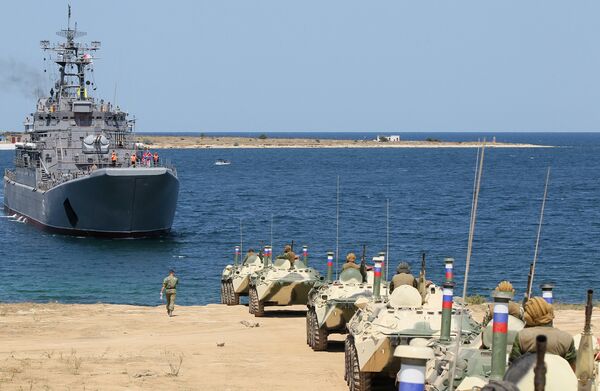A naval infantry unit landing on floating armored personnel carriers has been one of the highlights of a recent review of the Black Sea fleet in Sevastopol. Two companies disembarked from two large landing ships Yamal and Tsezar Kunikov, while other naval infantry units demonstrated hand-to-hand combat skills.
Like Russia's entire army, its naval infantry is in the process of reform. Some of its units are being abolished, others restructured or retrained. The training pace, officers say, has now increased - to compensate for the reduced numbers. One man's training is even more important in such conditions, and here the naval infantry is experiencing the same problems as the rest of the Russian armed forces: fewer servicemen on contract, short terms of service for draftees, and more effort needed to keep troops in fighting form.
In other words, conscripts join the reserve after just mastering the basic skills, while there are too few contract personnel to provide enough non-commissioned officers and specialists.
In the naval infantry, where, as in the navy in general, an individual plays a much greater role than in motorized rifle units, this problem is particularly acute.
It cannot be solved within the armed forces alone. One-year service in Russia was introduced for several reasons, and one of them was political. It was believed the Russian army would be like Western armies with their short call-up periods. But these armies have a sufficient number of contract servicemen, well over the 15% available in Russia.
Contract personnel numbers can be increased only if the state spends more on the pay for soldiers, sailors, sergeants and master sergeants and trains more petty officers and specialists.
The naval infantry's weapons also require attention. And their rearmament is under way. The Black Sea naval infantry, for example, is getting new self-propelled artillery guns and new trucks. The Marines also use updated Kalashnikov rifles. On the other hand, outdated armored personnel carriers, criticized by many, including First Deputy Defense Minister Vladimir Popovkin, are still in service, while the large landing ships in current use were built in Poland on Soviet orders.
These ships need to be replaced just as much as do the armored personnel carriers. What can replace them? Certainly not a Mistral-type ship, the negotiations on whose construction for Russia are nearing completion.
Such an ocean-going ship will come in handy if the Black Sea fleet operates far away, say off Eastern Africa, but should such operations ever be conducted, it will be in cooperation with other fleets. The navy's top leadership seems to be of the same view. Its representatives have often said that it is planned that ships of the Mistral type will be used by the Northern and Pacific fleets.
The construction of three to four large landing ships under Project 1177.1 may do a great deal to strengthen the Black Sea naval infantry. Their type ship Ivan Gren is expected to join the navy in 2011. Combined with several newly built hovercraft vessels, it will enable the Black Sea naval infantry to fulfill all realistic missions.
The ships of the new project can perform more tasks than today's vessels, allowing the naval infantry to undertake peacekeeping operations away from its own sea and using the ship as a home base.
The naval infantry has traditionally been elitist and remains so to this day. But in Soviet days it was viewed above all as the "spearhead", as the cutting edge of a landing force whose mission was to clear their way to securing a foothold, capturing a port where the main land forces and their heavy weapons transported by sea could land. Now their objectives are changed. What used to be secondary goals has come to the fore.
The naval infantry is gaining value as one of the most pliant instruments of the navy. Any naval unit, with naval infantry added, becomes capable of waging its own "limited war" on shore and of achieving the required results. These may be the pacification of the combatant sides, taking out key targets - using its own units, or involving the strike potential of ships and naval aviation - or protecting shipping, including the destruction of pirate bases. Finally, the naval infantry still remains the assault wave of a landing operation in case of a full-scale war.
However, it is the level of training, not of rank-and-file sailors, but of senior and top commanders, that guarantees the success of the naval infantry and the navy as a whole. This success depends on to what extent the senior officers who staff these headquarters are aware of the altered nature of present-day conflicts and war as a whole. And also on how competent they are as they act in a rapidly changing situation with conflicting information, the uncertain status of parties to the conflict, and many other factors.
Should this type of armed forces reform fail to bring about the required changes, the outlook could be very disturbing.
RIA Novosti military commentator Ilya Kramnik
The opinions expressed in this article are the author's and do not necessarily represent those of RIA Novosti.



